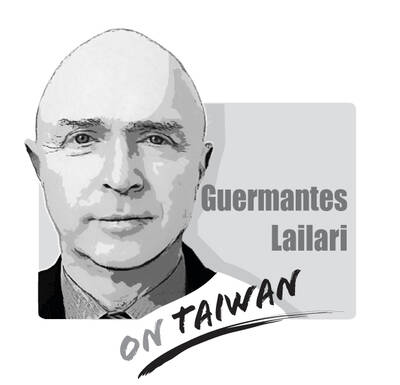President Chen Shui-bian (陳水扁) exchanged greetings and shook hands twice with US Sec-retary of State Colin Powell as he attended the state banquet arranged by Panamanian President Mireya Moskoso. This Chen-Powell meeting was made possible thanks to the Panamanian government's meticulous arrangements. This is the most rewarding part of Chen's trip to Panama.
Although Taiwan and Panama have maintained relatively stable relations, rumors of discord have surfaced every now and again.
Taiwan is at a disadvantage competing with China in Panama. In terms of economic statistics, China enjoys a far closer relationship with Panama than does Taiwan. China-Panama bilateral trade in 2001 reached US$1.241 billion, while the trade volume between Taiwan and Panama that same year was US$120 million.
China is the third-biggest user of the Panama Canal. Hutchison Whampoa, which operates the ports of Cristobal and Balboa at each end of the Panama Canal, enjoys close ties with China. The business fees the company pays annually are very important for the Panamanian government. Under these circumstances, Taiwanese diplomats have been under great pressure, especially after 1996 when China and Panama set up trade representative offices.
There was a breakthrough in August, however, when Taiwan and Panama signed a free-trade agreement (FTA), an important indicator of bilateral relations.
Every country has political and economic considerations when signing FTAs. Taiwan gave a great preferential deal to Panama's agricultural produce and even promised to offer an annual duty-free import quota of 5,000 tonnes of sugar. Panama could even make Taiwan its springboard to enter the Asian market.
For the Taiwanese govern-ment, however, the import value from Panama only totals US$4.8 million, accounting for a small proportion in the nation's foreign trade. Therefore, after the FTA takes effect, its impact on the Taiwanese market will be limited.
But this FTA won't just benefit Panama. The Taiwanese government also benefits from expanding businesses into American countries. Moreover, Taiwanese businesspeople investing in Panama enjoy the same treatment extended to Panamanian nationals. Panama also promised to open up its finance, land transportation, tourism, logistics and value-added telecommunications service industries.
In general, the FTA covers three main areas: trade liberalization, expedition and economic cooperation. If these can be implemented step by step, Taiwan-Panama relations will gradually develop into a more refined network. Our efforts made Panama's first Vice President Arturo Vallarino call off a trip to Beijing on Aug. 30 at the last minute. This symbolizes the fruit we have harvested from the long-term cultivation of diplomatic relations with Panama.
Chen's transit stop in the US en route to Panama implies a possibility that we can make use of the US factor. Although the US has formally returned the Panama Canal to Panama, the Panama Canal Treaty of 1977 stipulates that the US shall have primary responsibility to protect and defend the canal when facing any armed attack or other actions that threaten the security of the canal or of ships passing through it. It suggests the intervention of the US anytime in the name of security. Apart from that, Panama's deep dependence on US trade and investment has forced the country to heed the US' stance.
In the future, Taiwan should closely integrate its diplomatic efforts in the US with those in Panama and other Central American countries so as to bring its overall strength into full play.
Teng Chung-chian is a visiting scholar at the Sigur Center for Asian Studies at George Washington University and a professor of diplomacy at National Chengchi University.
Translated by Jackie Lin

“History does not repeat itself, but it rhymes” (attributed to Mark Twain). The USSR was the international bully during the Cold War as it sought to make the world safe for Soviet-style Communism. China is now the global bully as it applies economic power and invests in Mao’s (毛澤東) magic weapons (the People’s Liberation Army [PLA], the United Front Work Department, and the Chinese Communist Party [CCP]) to achieve world domination. Freedom-loving countries must respond to the People’s Republic of China (PRC), especially in the Indo-Pacific (IP), as resolutely as they did against the USSR. In 1954, the US and its allies
A response to my article (“Invite ‘will-bes,’ not has-beens,” Aug. 12, page 8) mischaracterizes my arguments, as well as a speech by former British prime minister Boris Johnson at the Ketagalan Forum in Taipei early last month. Tseng Yueh-ying (曾月英) in the response (“A misreading of Johnson’s speech,” Aug. 24, page 8) does not dispute that Johnson referred repeatedly to Taiwan as “a segment of the Chinese population,” but asserts that the phrase challenged Beijing by questioning whether parts of “the Chinese population” could be “differently Chinese.” This is essentially a confirmation of Beijing’s “one country, two systems” formulation, which says that
On Monday last week, American Institute in Taiwan (AIT) Director Raymond Greene met with Chinese Nationalist Party (KMT) lawmakers to discuss Taiwan-US defense cooperation, on the heels of a separate meeting the previous week with Minister of National Defense Minister Wellington Koo (顧立雄). Departing from the usual convention of not advertising interactions with senior national security officials, the AIT posted photos of both meetings on Facebook, seemingly putting the ruling and opposition parties on public notice to obtain bipartisan support for Taiwan’s defense budget and other initiatives. Over the past year, increasing Taiwan’s defense budget has been a sore spot
Media said that several pan-blue figures — among them former Chinese Nationalist Party (KMT) chairwoman Hung Hsiu-chu (洪秀柱), former KMT legislator Lee De-wei (李德維), former KMT Central Committee member Vincent Hsu (徐正文), New Party Chairman Wu Cheng-tien (吳成典), former New Party legislator Chou chuan (周荃) and New Party Deputy Secretary-General You Chih-pin (游智彬) — yesterday attended the Chinese Communist Party’s (CCP) military parade commemorating the 80th anniversary of the end of World War II. China’s Xinhua news agency reported that foreign leaders were present alongside Chinese President Xi Jinping (習近平), such as Russian President Vladimir Putin, North Korean leader Kim